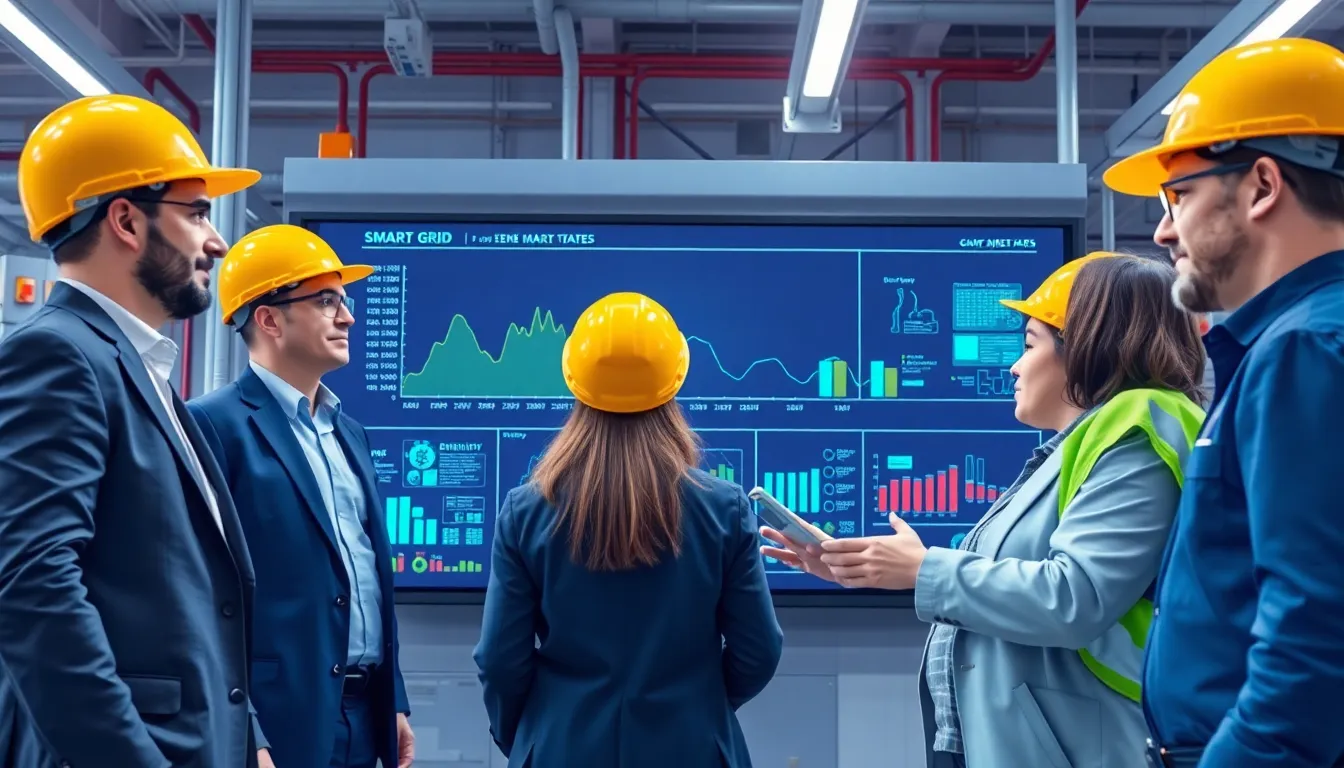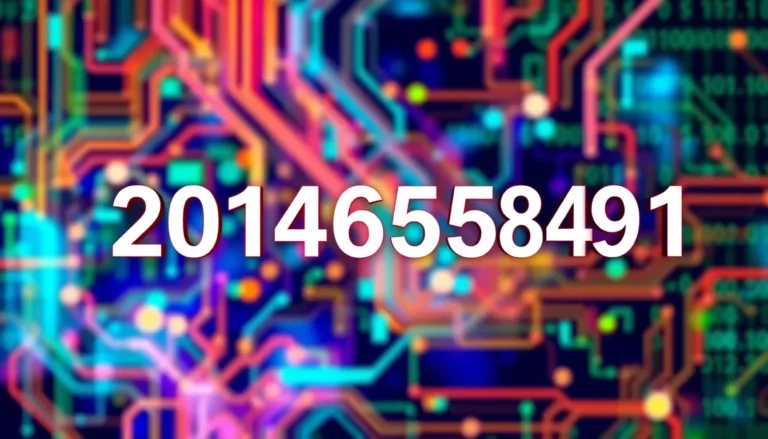The Internet of Things (IoT) is shaking up the energy sector like a toddler with a juice box. Imagine smart devices chatting away, optimizing energy use, and making life easier while saving the planet. It’s not just a sci-fi dream; it’s happening right now.
As energy companies embrace IoT, they’re transforming everything from how we monitor consumption to how we manage renewable sources. Sensors and smart meters are the new superheroes in this energy revolution, swooping in to save the day with real-time data and insights. With these innovations, efficiency skyrockets and costs plummet, making it a win-win for consumers and providers alike.
Get ready to dive into the electrifying world of IoT in the energy sector, where technology meets sustainability, and the future is not just bright—it’s brilliantly connected.
Table of Contents
ToggleOverview of Internet of Things in Energy Sector
The Internet of Things (IoT) significantly transforms the energy sector by integrating smart technology with traditional energy systems. Smart devices optimize energy usage by communicating directly with consumers and energy providers. With sensors and smart meters, operators enjoy real-time data on energy consumption, leading to enhanced management of resources.
Renewable energy resources benefit from IoT integration through improved storage and distribution capabilities. Smart grids utilize data analytics to forecast demand and supply dynamics, creating a more efficient energy flow. With advanced predictive maintenance, utility companies reduce downtime and operational costs.
Remote monitoring of energy infrastructures allows quick identification of issues, significantly lowering repair times. In addition, IoT applications enable better energy efficiency practices by informing users about their real-time consumption patterns. Users can receive alerts about peak usage times, aiding in implementing strategies that minimize costs.
Consumers appreciate smart home devices that automatically adjust settings based on energy pricing and availability. Such adjustments empower households to reduce energy bills while contributing to sustainable practices. The implementation of IoT also facilitates integration with electric vehicles, allowing for charging during off-peak hours.
Data collected from IoT systems enhances regulatory compliance and optimizes performance for several energy providers. It also fosters transparency, ensuring consumers remain informed about their energy consumption and related costs. Overall, the IoT’s presence in the energy sector heralds a future marked by efficiency, sustainability, and innovation.
Key Applications of IoT in Energy Sector

The Internet of Things (IoT) significantly reshapes the energy sector, driving efficiency and innovation through various applications. Key areas of impact include smart grids, predictive maintenance, and energy management systems.
Smart Grids
Smart grids use IoT devices to monitor and respond to energy needs in real-time. Sensors collect data on energy flow, allowing for optimized supply and demand management. Improved communication between utilities and consumers leads to dynamic pricing models, maximizing energy efficiency. Enhanced forecasting tools also adjust energy distribution according to usage patterns. Transitioning to smart grids has proven successful in reducing outages and enhancing reliability of energy services.
Predictive Maintenance
Predictive maintenance leverages IoT sensors to predict equipment failures before they occur. This technology continuously monitors the condition of energy infrastructure, enabling timely interventions. Utilities benefit from reduced downtime and operational costs, as maintenance can occur during optimal times rather than after failures. Increased reliability results from addressing issues proactively, ultimately enhancing service delivery. By adopting predictive maintenance, companies improve asset longevity and consumer satisfaction.
Energy Management Systems
Energy management systems utilize IoT to streamline energy consumption across multiple devices. These systems gather and analyze data on energy usage patterns, helping organizations make informed decisions. Automated controls adjust settings based on real-time energy pricing and availability, promoting cost savings. Users receive insights into their consumption, allowing for proactive energy-saving measures. This intelligent approach not only reduces costs but also supports sustainable energy practices.
Benefits of Implementing IoT in Energy Sector
Implementing IoT in the energy sector yields numerous benefits, driving efficiency, cost savings, and improved reliability.
Increased Efficiency
Efficiency gains become evident through the integration of IoT technologies. Smart devices monitor energy usage in real time, allowing for immediate adjustments. Data analytics enable utilities to optimize energy distribution based on actual demand. Automated systems reduce waste during peak and off-peak hours, enhancing overall system performance. Utilizing sensors also improves the management of renewable resources, facilitating seamless energy integration. Enhanced collaboration among devices promotes a responsive energy ecosystem, reducing bottlenecks in energy flows. As a result, energy providers and consumers experience seamless service, leading to a win-win situation.
Cost Savings
Cost savings represent another significant advantage of IoT adoption. Real-time data collection allows utilities to identify inefficiencies and address them promptly, reducing operational costs. Smart meters empower consumers to track their energy consumption, enabling better budgeting and reduced bills. Automated demand response systems adjust energy usage according to pricing signals, encouraging users to shift consumption to off-peak hours. Additionally, predictive maintenance minimizes downtime, cutting repair expenses significantly. These savings extend to both consumers and energy providers, making IoT a financially savvy investment in the energy sector.
Improved Reliability
Reliability improvements become paramount as IoT transforms energy systems. IoT sensors can detect potential failures before they occur, facilitating proactive maintenance. This predictive capability reduces unexpected outages, enhancing system resilience. Enhanced monitoring provides utilities with timely insights into energy infrastructure health, enabling swift interventions. Remote diagnostics streamline repair processes, lessening the impact of service interruptions. Improved reliability ultimately builds consumer trust, ensuring a steady supply of electricity while supporting grid stability. The integration of IoT fosters a robust energy network that meets modern demands with confidence.
Challenges and Risks
The integration of IoT in the energy sector introduces several challenges and risks that stakeholders must address. Security and data privacy are prominent concerns that can impact operations and consumer trust.
Security Concerns
Security vulnerabilities pose significant threats to IoT-equipped energy systems. Cyberattacks can lead to disruptions in energy supply and unauthorized access to sensitive data. Attackers may exploit weaknesses in connected devices, allowing them to manipulate energy management systems or launch distributed denial-of-service attacks. Utilities need robust security measures, such as encryption and network segmentation, to safeguard critical infrastructure. Regular updates and patches for software also play a crucial role in mitigating risks. Collaboration between companies and cybersecurity experts is essential for developing resilient systems.
Data Privacy Issues
Data privacy issues arise from the vast amounts of information collected by IoT devices. Energy consumption patterns, personal identifiers, and usage habits can become vulnerable to unauthorized access. Consumers often face the risk of having their data mismanaged or misused by third parties. Regulations such as the General Data Protection Regulation (GDPR) aim to protect personal data and ensure transparency in its use. Compliance with these regulations necessitates the implementation of strict data governance frameworks. Energy companies must prioritize user consent and inform customers about data collection and usage practices to build trust.
Future Trends in IoT for Energy Sector
Emerging advancements in IoT technology continue to reshape the energy sector. Increased deployment of artificial intelligence and machine learning enhances data analysis, enabling real-time adjustments in energy systems based on consumption patterns. Smart grids evolve, leveraging advanced algorithms to improve predictive analytics and optimize energy distribution.
The rise of decentralized energy resources necessitates enhanced IoT capabilities. Distributed generation systems, such as solar panels and wind turbines, rely on IoT for efficient integration into the grid. These systems utilize real-time data to adapt operations and balance supply with demand seamlessly.
Energy storage solutions benefit from IoT innovations, ensuring effective management of battery systems. Smart batteries communicate with energy networks to optimize discharge and recharge cycles, maximizing efficiency. Increased battery usage correlates with greater reliance on renewable energy, further diversifying energy sources.
Consumers increasingly adopt connected devices for energy management. Home automation systems allow homeowners to monitor and control energy consumption efficiently. Devices tailored for demand response present opportunities for users to reduce costs by adjusting usage during peak periods.
Regulatory frameworks are becoming more supportive of IoT-integrated energy solutions. Policymakers recognize the importance of promoting clean energy technologies and infrastructure investments. Enhanced interoperability standards will soon facilitate smoother integration of various IoT devices across energy systems.
Heightened focus on cybersecurity ensures IoT systems remain resilient against threats. Strategies include employing advanced encryption and cybersecurity protocols to protect data integrity. Active monitoring systems aim to detect vulnerabilities proactively, enhancing overall security.
Investment in IoT technologies within the energy sector is poised for significant growth. Stakeholders anticipate the development of smart cities leading to smarter, more sustainable energy solutions. This evolution reinforces the commitment to efficiency, reliability, and sustainability in energy management.
The Internet of Things is revolutionizing the energy sector by driving efficiency and sustainability. With smart devices and advanced data analytics, energy management is more effective than ever. Consumers and providers alike benefit from real-time insights that optimize usage and reduce costs.
As the sector continues to evolve, addressing security and data privacy concerns will be essential. The integration of IoT with emerging technologies promises to enhance energy systems further. Investment in these innovations will pave the way for a more reliable and sustainable energy future. Embracing IoT is not just a trend; it’s a crucial step toward a smarter energy landscape.



